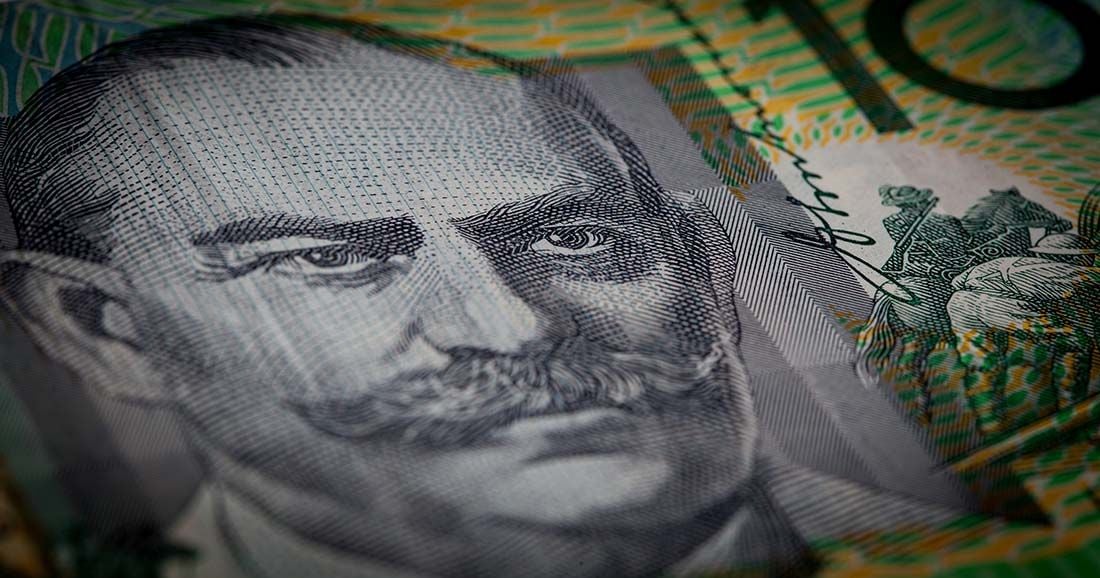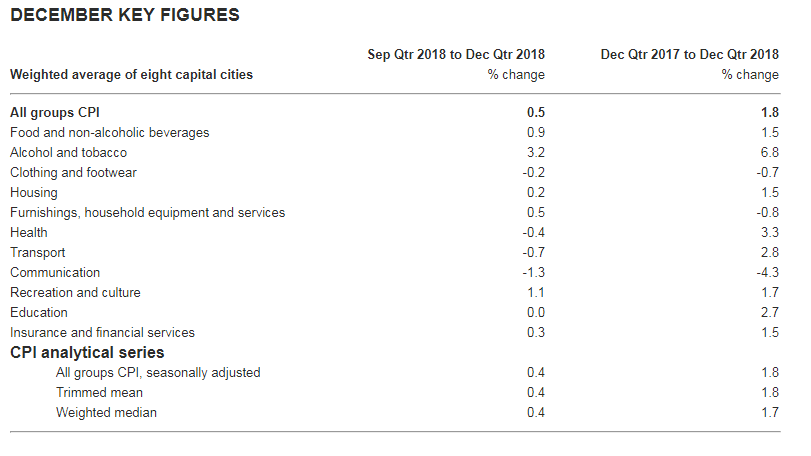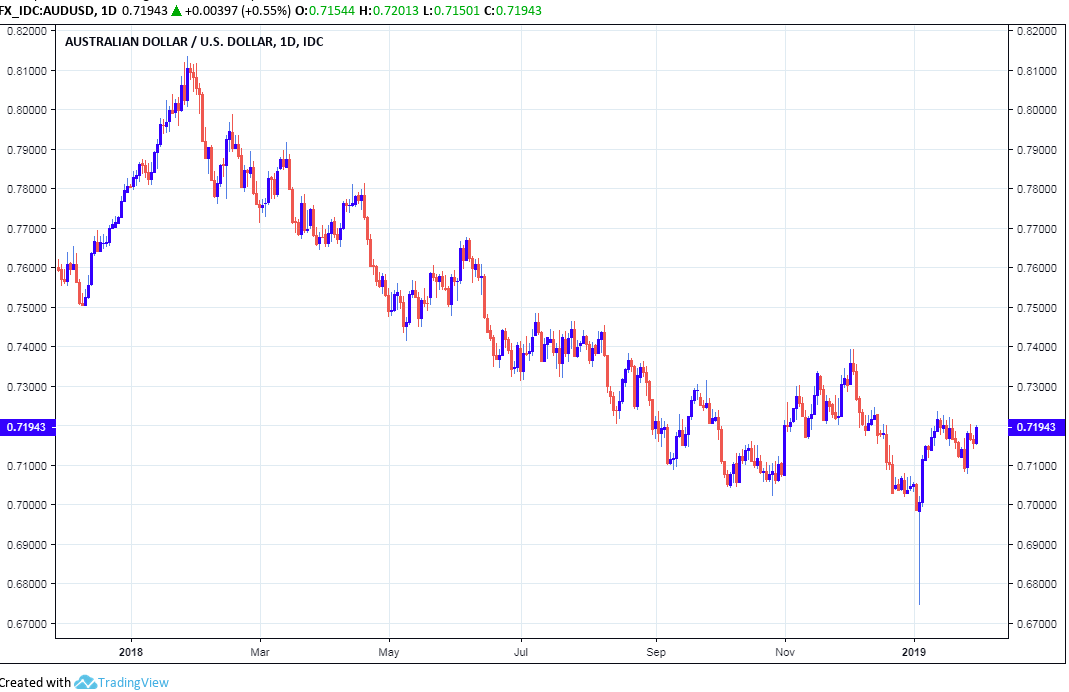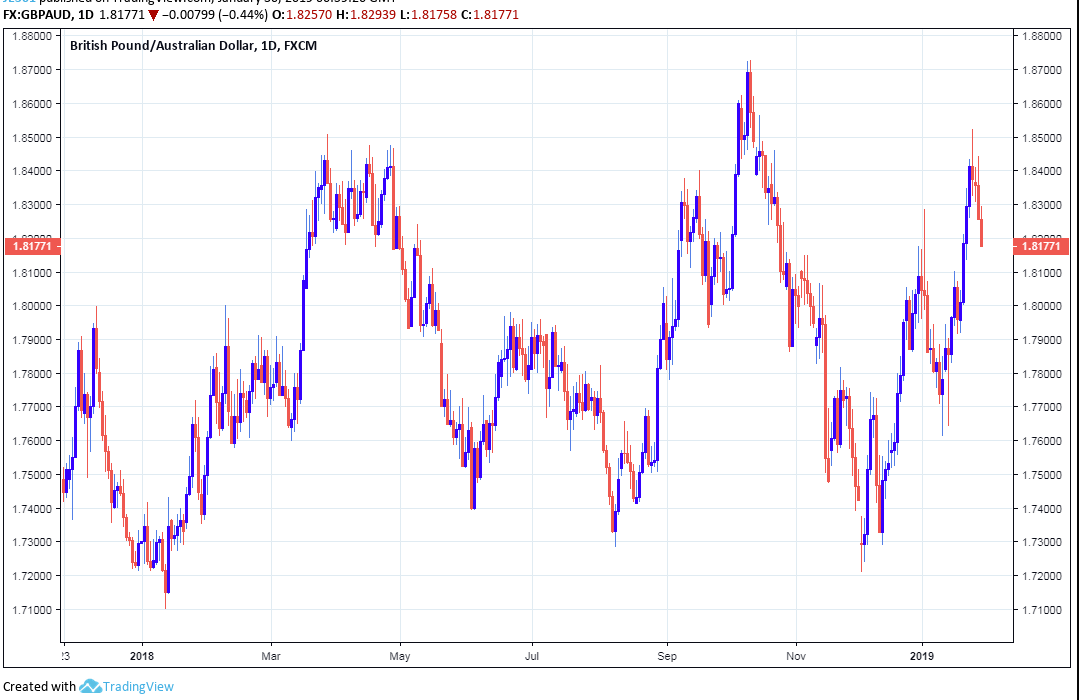The Australian Dollar Pops after Inflation Surprise but Jury Still Out on RBA Rate Cut
- Written by: James Skinner

© Greg Brave, Adobe Stock
- AUD rises broadly after Q4 inflation surprises on the upside.
- Market looks for CPI decline to encourage rate cut speculation.
- HSBC says sell the AUD as rarified territory on charts awaits.
The Australian Dollar rose broadly Wednesday after inflation surprising on the upside for the final quarter, although gains could prove short-lived because the jury is still out on whether an Reserve Bank of Australia (RBA) interest rate cut is in the cards for the months ahead.
Inflation rose by 0.5% during the final quarter of 2018, up from 0.4% previously and ahead of the economist consensus for an unchanged reading of 0.4%.
Despite the quarterly surprise, the annualised rate of inflation declined from 1.9% to 1.8% during the final months of the year, although this was above the consensus for a reading of 1.7%.
“The largest contributions came from the 9.4% increase in tobacco prices and a 6.2% lift in domestic airfares. Offsetting this slightly was a 2.5% fall in petrol prices,” says Jack Chambers, an economist at Australia & New Zealand Banking Group (ANZ).
Trimmed mean inflation came in at 0.4% for the period, unchanged from in the prior quarter, although differences in how this measure is calculated mean the annualised rate remained steady at 1.8%.
Trimmed mean inflation strips out the most volatile 30% of items from the goods basket, which are often food and energy items, so is thought to provide a better reflection of domestically generated inflation pressure.

Above: Australian inflation by category. Source: Australian Bureau of Statistics.
“We expect headline CPI to be broadly similar in Q1 2019. The challenge for the RBA is that their November forecast needs an acceleration in core inflation in the first half of 2019 to achieve the expected core pick of 2% by June 2019. This looks difficult given the economy’s loss of momentum in the second half of 2018,” Chambers adds.
Markets care about inflation because it has implications for interest rates, which are the primary tool that central banks use to manage price pressures, as well as the driver behind most moves in exchange rates.
Changes in rates are only normally made in response to movements in inflation but impact currencies because of the push and pull influence they have on international capital flows and their allure for speculators.
“The latest inflation figures reinforce our view that interest rates will remain at record lows for a long while,” says Lee Sue Ann, an economist at UOB Bank. “Financial markets have been pricing in a greater than even chance the official cash rate will be lowered by the end of the year.”

Above: AUD/USD rate shown at daily intervals.
The AUD/USD rate was quoted 0.54% higher at 0.7195 during early trading Wednesday and is up 1.9% for 2019.
The Pound-to-Australian-Dollar rate was quoted -0.48% lower at 1.8186 and has risen just 0.49% so far this January.
The Aussie was higher against all G10 currencies on Wednesday, supported by a tailwind from rising iron ore prices.
“Iron ore futures (Dalian exchange) increased more than 4% as producer Vale announced decommissioning plans. The futures’ increase suggests that iron ore could breach US$80/t in coming days and stay above that level until Vale’s production outlook becomes clearer,” says Richard Grace, head of FX strategy at Commonwealth Bank of Australia.

Above: Pound-to-Australian-Dollar rate shown at daily intervals.
Inflation has spent much of the last three years below the 2%-to-3% target band of the RBA, leading the central bank to hold its interest rate at a record low of 1.5% for more than two years, even as other central banks hike their own rates and put pressure on the Aussie currency in the process.
Below-target inflation and wage pressures that are insufficient enough to facilitate a sustainable return of the consumer price index to within the target band are the main reason for the RBA’s policy stance.
However, a slowdown in the economy during the latter half of 2018 and litany of risks that threaten the growth outlook this year, including the U.S.-China trade war, have led markets to begin betting the RBA will soon be forced to cut its interest rate.
“The recovery in core inflation from the end-2016 low of 1.43%/yr remains painfully 'gradual' and leaves the RBA on the sidelines for some time, but there is no justification for dropping the "next move is up" tightening bias next week. There are three lots of RBA-speak to digest, and then after Q4 wages on Feb 20,” says Annette Beacher, chief Asia Pacific macro strategist at TD Securities.
The RBA interest rate statement due on Tuesday 05, February will be key to the outlook for the currency during the months ahead, with markets looking to see whether the bank maintains its guidance that “the next move in rates is up”.
Investors are already betting in the interest rate derivative markets there is close to a 100% chance the RBA will cut its cash rate before February 2020. The market-implied interest rate for that month was 1.29% on Tuesday, almost a full rate step below the current 1.5% record low cash rate.
This pricing of an RBA rate cut has weighed heavily on the Australian Dollar in recent months so anything that encourages the market to be less pessimistic about the interest rate outlook could provide the Antipodean currency with a powerful shot in the arm.
“We detect a solid resistance zone at 0.7235/50 and AUD may find it difficult to break above these levels,” says UOB’s Ann. “We expect the current upward pressure to persist unless AUD drops back below 0.7090. AUD/USD traders will be closely monitoring trade talks between Chinese Vice Premier Liu He and US Trade Representative Robert Lighthizer this week.”
Time to move your money? Get 3-5% more currency than your bank would offer by using the services of foreign exchange specialists at RationalFX. A specialist broker can deliver you an exchange rate closer to the real market rate, thereby saving you substantial quantities of currency. Find out more here.





